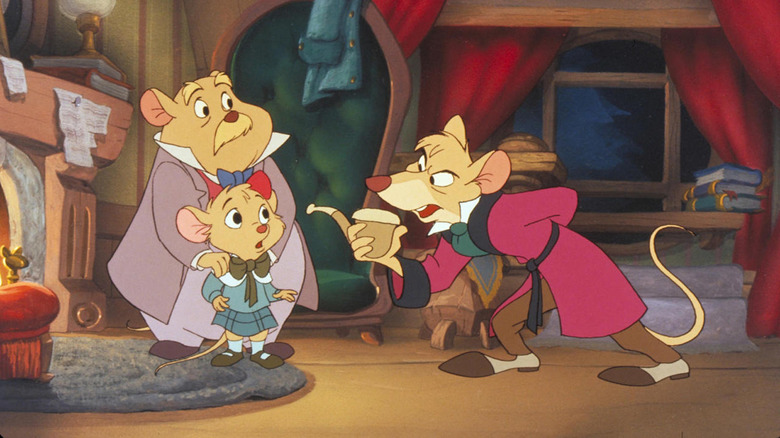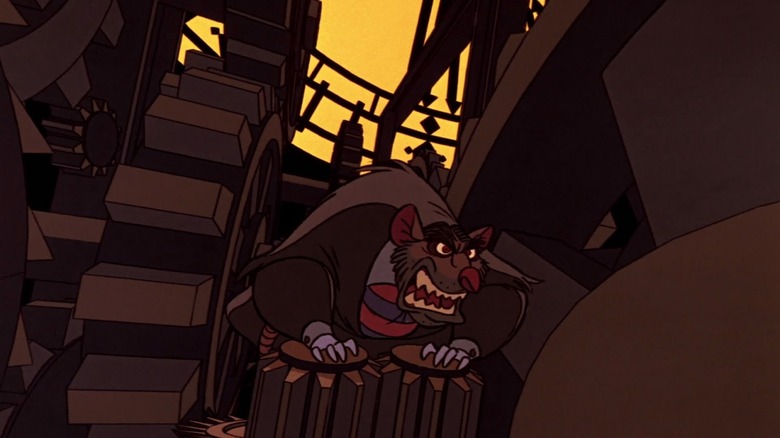How The Great Mouse Detective Was A CGI First For Disney
An underrated Disney classic, "The Great Mouse Detective" was released in 1986. Though it was a modest commercial success, the film was soon overshadowed by another mouse-centric movie. Former Mouse House animator and Disney's main competition at the time, Don Bluth (along with Steven Spielberg), released "An American Tail" shortly thereafter. Although "The Great Mouse Detective" has largely faded into obscurity, it's definitely a major highlight of Disney's so-called "Dark Age."
The film is based on the series of children's books, "Basil of Baker Street" by Eve Titus and Paul Galdone, which are themselves a riff on the Sherlock Holmes books by Arthur Conan Doyle. Named for Basil Rathbone, who famously portrayed Holmes in film, Basil (Barrie Ingham), his partner Dr. Dawson (Val Bettin), and their trusty hound Toby must face off against the villainous Ratigan (voiced by the incomparable Vincent Price) to help reunite a young mouse named Olivia with her father, who had been kidnapped. While undoubtedly a family film, its creepy, noir feel separates the movie from much of the Mouse House's other work.
Aside from being a delightful film, "The Great Mouse Detective" was a major first for Disney animation. While often cited as the first Disney movie to utilize computer-generated imagery, that honor actually belongs to "The Black Cauldron," which was such a flop that the Mouse House seems determined forget its existence altogether. In fact, "The Black Cauldron" almost ended Disney animation, while "The Great Mouse Detective" helped to save it. Though "The Black Cauldron" was technically Disney's first film to feature CGI, it was used for a much more complex sequence in "The Great Mouse Detective." So what sort of groundbreaking computer animation was used in the movie?
The sequence runs like clockwork
"The Great Mouse Detective" wraps up with a climactic chase through Big Ben to rescue Olivia. It's an impressive sequence made all the more fascinating by the details behind it. The scene blends computer-generated backgrounds with hand-drawn characters.
Animator Phil Nibbelink explained:
"Once we've done the computer graphics on the screen, the computer, with a ball point pen and a mechanical hand, draws what was on the screen onto an animation piece of paper."
Once that background — in this case, the gears of a clock — is completed, the animators come in and hand draw the characters over it. This technique made it possible to shoot the scene in ways Disney was unable to before. Unlike "The Black Cauldron," which mostly used CGI to create certain objects or effects, the "The Great Mouse Detective" scene was a true amalgam of computer and hand-drawn animation.
Nibbelink continued:
"With the entire room and architecture and gears and beams and the clock face all in the computer's mind, we could then move through the set just like a live-action camera could do or even more like a helicopter can do."
The ability to follow the characters as they race through this maze of gears simply wasn't possible before adding computers to the mix. It's a scene that still looks pretty great today, very much propelled by the energy of running through this maze right along with Basil.
Interestingly, though "The Black Cauldron" hit theaters a year earlier in 1985, and is thus given the distinction of being the first Disney film to use CGI, that movie and "The Great Mouse Detective" were actually being worked on at the same time, and the latter was finished first. In fact, when a producer on the former heard about the groundbreaking use of computers in "The Great Mouse Detective," he enlisted that team to use computers to animate certain objects in his film as well, most notably the titular cauldron (via Decider).
When comparing some CGI elements in "The Black Cauldron" to the Big Ben sequence in "The Great Mouse Detective," it's easy to see how the inferior animated feature has gotten lost in the annals of Disney's history. The scene in "The Great Mouse Detective" was a major stepping stone in what was to come for animation, especially given the leaps and bounds that would soon be made by Disney and Pixar with the Computer Animation Production System, also known as CAPS. It may seem like a small step, but it certainly was a vital one for the future of animation.

